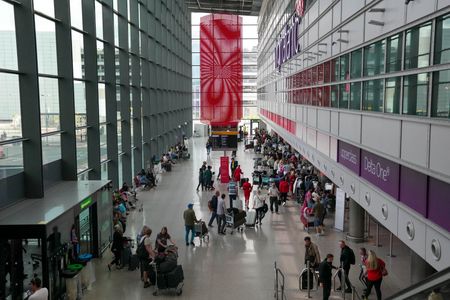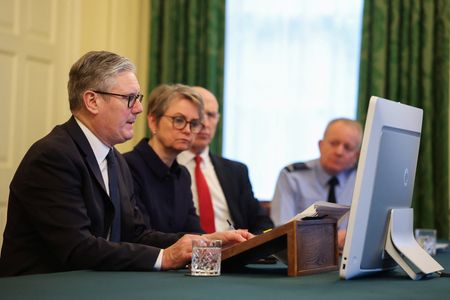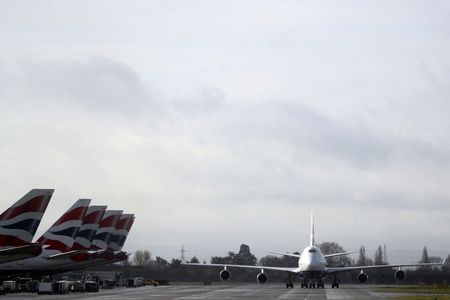By Sarah Young
LONDON (Reuters) -Britain selected Heathrow Airport’s plan to build a new runway on Tuesday, as the government pushes ahead with the country’s most controversial infrastructure project as part of its drive for growth.
But the 33-billion-pound ($43.4 billion) plan for one of the world’s busiest airports faces hurdles before construction can start, including securing development consent and overcoming environmental objections.
The government has said it wants planning consent for the new runway secured by 2029 and planes taking off by 2035.
WHY A THIRD HEATHROW RUNWAY NOW?
Finance minister Rachel Reeves wants to breathe life into Britain’s economy and says infrastructure projects will help drive growth by luring investment – and in Heathrow’s case by boosting trade and tourism.
The Labour government is under pressure over the economy and Reeves is expected to announce tax rises in Wednesday’s budget.
Heathrow Airport operates at 99% capacity and could be overtaken as Europe’s busiest airport in coming years. Its two runways compare with four each at Paris’ Charles de Gaulle and Frankfurt Airport, and six at Amsterdam’s Schiphol.
WHAT IS THE HISTORY OF THE HEATHROW EXPANSION PLAN?
Heathrow’s third runway got the green light in 2009 but the plan was scrapped in 2010 after a change of government. That sparked ideas about building a new hub airport east of London, before a commission recommended a new runway at Heathrow in 2015.
In 2020, Britain’s top court gave Heathrow’s third runway the green light but that was during the COVID-19 pandemic, which brought air traffic to a standstill.
Heathrow then focused on travel recovery. In 2024, passenger numbers jumped to 84 million, overtaking a pre-pandemic high and putting the third runway back on the agenda.
WHAT ARE THE ENVIRONMENTAL OBJECTIONS TO THE EXPANSION?
Heathrow is 15 miles (24 km) west of London. Residents have long complained about noise pollution, air quality and soaring carbon emissions from flight paths that mostly go over the city.
Past attempts to expand Heathrow have faced legal challenges from environmental groups and local opposition groups. Such groups could seek a judicial review of the government’s decision.
Increasing use of sustainable aviation fuel will help cut carbon emissions from flying in future and help boost the case for expansion, which the government needs to square with Britain’s legally binding net zero targets.
Britain has said at least 10% of all jet fuel used in flights taking off from Britain should be sustainable fuel by 2030, but current usage is very low and electric airplanes are deemed a long way off by experts.
In Heathrow’s favour is the government’s aim to overhaul planning rules to make it easier to build – legislation which is now going through parliament.
Transport minister Heidi Alexander last month launched a review of the Airports National Policy Statement which will help shape plans in line with climate obligations and should be completed by the end of 2026.
HOW WILL IT BE PAID FOR?
Privately owned Heathrow Airport has said the expansion will be privately financed. It has estimated that the new runway will cost 21 billion pounds, including a 1.5-billion-pound bill to reroute the nearby M25 motorway, plus 12 billion pounds for associated terminal infrastructure. It is already spending 15 billion pounds on airport upgrades.
The airport, owned by France’s Ardian, the Qatar Investment Authority, Saudi Arabia’s Public Investment Fund and other investment groups, wants a long-term funding framework in place to provide comfort over future returns on its investment in the new runway. But airlines have said they do not want to be saddled with big rises in fees to pay for expansion.
“Expansion at Heathrow must minimise cost for passengers and customers,” Alexander said in October.
Heathrow Airport said on Tuesday it needed clarity by mid-December on how the project’s next phase would be regulated.
WHAT OTHER CHALLENGES ARE THERE?
The Heathrow proposal involves London’s orbital motorway going through a new tunnel, a complex project on a congested route which the boss of British Airways has criticised.
Also, the number of construction workers in Britain is falling as the government pushes other big projects.
($1 = 0.7611 pounds)
(Reporting by Sarah Young, Editing by Timothy Heritage)










